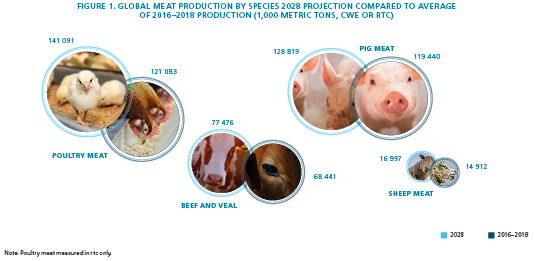Market news: Brazil, China, US lead poultry meat production to 2028
Although the largest-producing countries still dominate global poultry production volume, new regions are growing as well as new production technologies.
Poultry production continues to slowly grow over the next decade, according to the latest Agricultural Outlook projections by the Food and Agriculture Organization (FAO) and Organization for Economic Cooperation and Development (OECD). Production of poultry meat is set to rise from just over 121 million metric tons over the average of the base period 2016–18 to more than 141 million metric tons by 2028 (figure 1).
Of the species, poultry will continue to lead in the meat type produced over the next 10 years, thanks to the fact that its short production cycle allows producers to respond quicker than other meats to market demands and production benefits that make it more sustainable for the environment than some other animals. By 2028, some 141 million metric tons of poultry meat are projected by FAO to be produced, with pig meat forecast at almost 129 million metric tons, beef and veal production at nearly 77.5 million metric tons and sheep meat at just 17 million metric tons (figure 1).

For poultry, the production growth is expected to grow relatively even with the number of animals, which is not the case with some of the other agricultural products. The increase in poultry will account for nearly half of the total increase in meat production over the coming decade. This will be due to intensified production, taking advantage of favorable feed prices and at the same time expanding its production base (figure 2).
Overview of key players
As of 2018-19, FAO says the majority of poultry meat production comes from the regions of Asia, North and South America, and Europe, thanks to key market players like China, the U.S., Brazil and the European Union (figure 3).
